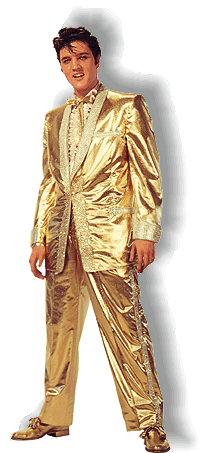 www.elvis.com
www.elvis.com |
Movie Studio History, 1 / 4
Movie Studio History
Part 1 of 4 in our look at the history of the movie business and the
various movie studios for which Elvis made his films:
In 1873, an English photographer, Eadweard Muybridge, spaced cameras
along a racetrack in order to capture the movement of a galloping
horse. Over the next ten years Muybridge and his assistants
continued to improve and perfect photographing animals and men in
motion. Meanwhile, George Eastman and Thomas Edison were each
separately working on new kinds of film. Eastman Kodak was working
on manufacturing rolled film - irst on paper, then on celluloid.
Edison was working on perforated film and developing a Kinetoscope,
which was a cabinet used to display film to one spectator at a time.
By 1894, Edison's assistant William Dickson was making films to show
on the Kinetoscope that lasted around 20 seconds and featured
vaudeville acts and famous personalities such as Buffalo Bill Cody.
In late 1895, French partners Louis and Auguste Lumiere patented a
camera and projector and opened the first public film show in Paris.
They brought their show to other countries including Britain and
America. Soon, inventors around the world were working on their own
versions of camera and projection systems.
In 1905, Pittsburgh, Pennsylvania was the site of the first
five-cent movie or nickelodeon. "Variety" magazine began publication
that same year. Films in 1899 had run just over a minute in length,
however, by 1906 they were 14 minutes. There were animated cartoons
by then as well as experiments in the use of scents in the cinema,
such as the smell of roses emitted into the theater during the
showing of the Rose Bowl game.
In 1911 came the first movie fan magazines. "Photoplay" and "Motion
Picture Story Magazine" were established. The year 1927 ushered in
the "talkies" as sound was added to film and performer Al Jolson
said most prophetically, "You ain't heard nothin' yet."
The technology continued to improve. Production companies and
studios continued to be formed. The animated Disney character Mickey
Mouse made his debut in "Steamboat Willie".
By 1933, the average time for making a film was 22 days and the
average cost was $70,000.
In 1935, child performer Shirley Temple topped the list of America's
money-making stars, along with Will Rogers, Clark Gable, Fred
Astaire and Ginger Rogers, and Joan Crawford. Early that year, a boy
was born in Tupelo, Mississippi and named of Elvis Presley.
Fast forward a couple of decades:
On Monday, March 26, 1956, new singing superstar Elvis Presley was
at Paramount Studios in Los Angeles to screen-test for producer Hal
Wallis. Mr. Wallis had heard about Elvis from his partner Joseph
Hazen, who had seen Elvis performing on the Dorsey Brothers' "Stage
Show" television program. Under the direction of Frank Tashlin,
Elvis performed two scenes from the script for the movie "The
Rainmaker". In one he acted opposite Frank Faylen. Elvis had made it
clear that his desire was to become a serious actor and to not sing
in the movies, however another part of his screen test was to
lip-synch to his recording of "Blue Suede Shoes" while holding a
prop guitar. They wanted to see if his energetic performances on
television and stage would translate well to film. Quickly, there
was little doubt of that.
Peter Guralnick, in his Elvis biography "Last Train To Memphis",
quotes screenwriter Allan Weiss, who was then a part of the sound
department and present at the screen test. Weiss said, "The
transformation was incredible...electricity bounced off the walls of
the soundstage.
One felt it as an awesome thing--like an earthquake in progress,
only without the implicit threat."
With that, Elvis began his movie career, eventually making a total
of thirty-one feature films as an actor and two
theatrically-released concert documentaries. |

 www.elvis.com
www.elvis.com